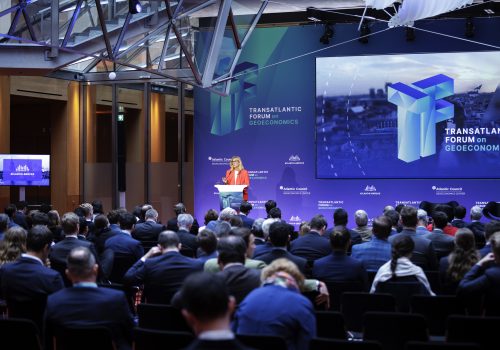By the numbers: Here’s how turmoil in Congress could impact US aid to Ukraine
The US policy of supporting Ukraine as it defends itself from Russian invasion has been caught up in brinkmanship over a government shutdown. A closer look at the numbers reveals that US aid can continue to flow for the next few weeks—but the picture after this fall is looking increasingly cloudy, and Ukraine’s needs are only getting more urgent.
The forty-five-day funding extension agreed to on Saturday night came at the price of excluding new funding for Ukraine aid. Angry that this extension was passed with Democratic support, the far right of the Republican caucus orchestrated a “motion to vacate” in which eight Republicans joined with the entire Democratic caucus to oust Speaker Kevin McCarthy.
McCarthy’s removal on Tuesday has overwhelmingly been read as bad news for Ukraine. But just how significant is it?
Ahead of the original budget deadline, the Biden administration was requesting $24 billion for Ukraine over the next fiscal year. The current forty-five-day funding bill does not include this, and alternative options to keep money flowing from the United States to Ukraine are limited.
Ukraine has an immediate need for not only military, but economic assistance as it has lost a large chunk of its gross domestic product. The United States has committed $26.4 billion in financial aid since the beginning of the full-scale invasion, making up 34 percent of total US aid, including military assistance. This has already been spent. The administration has also exhausted its ability to approve more emergency Presidential Drawdown Authority (PDA) funds as it reached its limit of $14.5 billion for fiscal year 2023, which allows the president to authorize the immediate transfer of articles and services from US stocks.
There is still some flexibility for the next forty-five days. Ukraine can draw from already approved funding. And while more PDA funds cannot be approved, the already-approved PDA does not have an expiration date and there are some funds left. The Department of Defense (DOD) has $5.4 billion worth of approved PDA and $1.6 billion left to replace weapons. Available funds are less than the requested $24 billion, however that sum would have been used over the course of three to four months, not just the next forty-five days. If the DOD uses its transfer authority to reallocate approved PDA or uses separate funds aimed at building long-term capacity, such as Foreign Military Financing (FMF), Ukraine could still receive a similar amount of funding to what it might have received during this shorter window.
In the meantime, Congress does not have to wait until the forty-five-day funding bill expires to approve the requested funds for Ukraine. Congress can pass a separate spending bill for Ukraine’s aid or include it in a combined bill for security spending, before or after the current funding bill expires. However, McCarthy’s ouster and the need to find a replacement will consume the House’s time and the frontrunners for speaker will likely have to appeal to the right flank of the Republican Party to secure a win.
The consensus for now is that the events of the past week make the outlook for US aid to Ukraine more difficult, at least in the short term. Even if the Pentagon manages to re-arrange funding to provide surveillance and technical assistance in the medium term, it will not be possible to keep supplying Ukraine with as many weapons. The strategies, which have worked well so far, including backfilling Ukraine’s European neighbors with new arms as they give their older Warsaw Pact supplies to Ukraine, cannot work without appropriated funding.
The whole executive branch and especially the president are now under pressure to re-state clearly the importance of supporting Ukraine. A public statement will remind Americans the reasons why supporting Ukraine is important, assure allies in the US commitment, and show Russian leader Vladimir Putin he is far from winning. If the United States stops or dramatically reduces its funding, the European Union’s (EU) institutions and member states, as well as other supporters of Ukraine, will try but struggle to come up with alternatives. The EU institutions already have committed a total of $54.65 billion in financial aid through 2027, but Ukraine’s state budget is running at a large deficit, averaging $3 billion-$4 billion a month. Direct financial aid has been filling that gap and, without the United States, this will become much more challenging.
Most worrying, though, is the fact that support for Ukraine is not some randomly selected bargaining chip. Sentiment among some Republican members in Congress is shifting away from the near-consensus of early 2022 faster than many expected. Former President Donald Trump has called for a moratorium on Ukraine funding, and he remains the most likely candidate to win the Republican presidential nomination for 2024. This is despite polls showing that support for Ukraine remains significant among Republicans, if lower than among Democrats. These debates will only get more heated—and more challenging for supporters of Ukraine—heading into an election year.
Yulia Bychkovska is a Young Global Professional for the Atlantic Council GeoEconomics Center’s Economic Statecraft Initiative. Follow her on X at @_YuliaB_.
Charles Lichfield is the deputy director and C. Boyden Gray senior fellow of the GeoEconomics Center. Follow him on X at @clichfield1.

At the intersection of economics, finance, and foreign policy, the GeoEconomics Center is a translation hub with the goal of helping shape a better global economic future.
Further reading
Thu, Sep 21, 2023
The West won’t seize Russia’s reserves any time soon. Here’s what it can do with the funds instead.
New Atlanticist By Kimberly Donovan, Charles Lichfield
Frozen Russian assets could be invested profitably, with the goal of creating an annuity for Ukraine of at least two billion dollars a year.
Fri, Sep 29, 2023
Five takeaways on the state of economic statecraft
New Atlanticist By Kimberly Donovan, Charles Lichfield
Sanctions and export controls have played a central role in the West’s response to Russia’s aggression against Ukraine, but there are other tools of economic statecraft, too.
Wed, Oct 4, 2023
Are Americans more supportive of Ukraine than Congress is?
New Atlanticist By Andrew D’Anieri
New polling provides further evidence that American public support for Ukraine remains robust and bipartisan, and may even be more forward-leaning than the opinions of many in Congress or the White House.
Image: Former Speaker of the House Kevin McCarthy (R-CA) speaks to reporters after he was ousted from the position of Speaker by a vote of the House of Representatives at the U.S. Capitol in Washington, U.S. October 3, 2023. REUTERS/Jonathan Ernst


